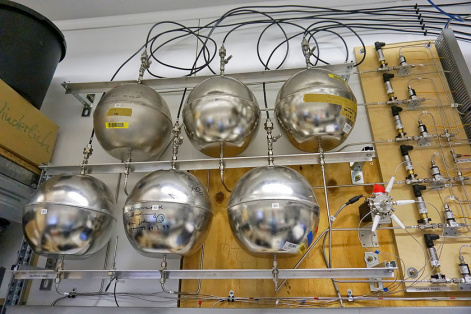A new station for monitoring the greenhouse gas concentration in the atmosphere has been launched on the coast of Taimyr
20 October 2021 г.

The recorded rate of increase in the air temperature in the Arctic is more than double the average for the Northern Hemisphere. For this reason, the past few decades have seen significant environmental changes in the Arctic. In particular, scientists note an increase in the productivity of vegetation cover and in the duration of the growing season, degradation of permafrost and increase in microbial decomposition of organic matter in soils. These processes can provoke an increase in greenhouse gas emissions into the atmosphere. At the same time, the Arctic is already considered a "hot spot" of the current and expected methane emissions on a global scale. At the same time, there are not many accurate observations of the dynamics of greenhouse gases in this vulnerable region. It is necessary to study how the dynamics of absorption and emissions of greenhouse gases in the Arctic Circle is changing and what consequences this can have.
A team of scientists from Russia and Germany, led by researchers from the Krasnoyarsk Science Center of SB RAS, has been continuously monitoring the concentration of greenhouse gases in the Arctic atmosphere on the western coast of the Taimyr Peninsula at the new DIAMIS station for several years. Based on observations of the seasonal variability of the concentration of carbon dioxide and methane in the atmosphere, the researchers estimated the regional features of the exchange of the studied greenhouse gases in the terrestrial ecosystem-ocean-atmosphere system. In winter, when carbon dioxide is not absorbed by vegetation, its background is formed mainly by anthropogenic emissions, in particular, from fuel combustion or from oil and gas fields. The difference between the content of carbon dioxide in the air in winter and in summer - at the peak of absorption by vegetation cover, is quite similar to observations made at other Arctic stations. It is this value that reflects the ability of natural ecosystems in the Siberian Arctic to absorb carbon from the atmosphere.
A large contribution to the dynamics of the greenhouse gas concentration in the coastal zone is made by the Arctic Ocean. This can especially be seen in summer. In winter, researchers note an increase in the impact of air from the continental part, which makes it possible to periodically observe anthropogenic signals of greenhouse gases coming, for example, from the oil and gas fields of the Yamal and Tazovsky peninsulas. However, in summer, there is a strong variability in the rates of absorption and release of carbon dioxide and methane by terrestrial ecosystems. The scientists note that these values are sensitive to changes in weather conditions and depend on whether the year is dry or wet, cold or warm. Natural fires also play an important role, contributing a significant amount of greenhouse gases to the atmosphere.
“According to measurements made in Dikson, we have been observing an increase in the concentration of carbon dioxide and methane in the atmosphere. We see a similar trend according to the 15-year monitoring data at the ZOTTO observatory in the middle taiga subzone of Siberia and at other measuring stations in the northern hemisphere. This is a global trend, which may indicate a certain loss of compensatory abilities of the biosphere. The same is observed over the forest areas of Siberia, especially in high latitudes. Research in different regions of the world with different natural and climatic conditions and different degrees of anthropogenic pressure should give an exact answer about the behavior of carbon. It is necessary that such research should be the long term one. With each new year, the series of such monitoring data will only become more valuable. Our research provides unique actual material about the existing trends in the change in the natural environment. The recently launched station for continuous monitoring of molar fractions of carbon dioxide and methane in the atmosphere in the west of the Taimyr Peninsula fills the gap in observations of atmospheric gases over the Arctic belt of the central part of Siberia, "said Aleksey Panov, Candidate of Biological Sciences, Scientific Coordinator of the ZOTTO Observatory of the V.N.Sukachev Institute of Forest SB RAS.
The studies at the coastal monitoring station in the area of the Dikson settlement are part of the project of the climatic scientific and educational center, recently created in Krasnoyarsk within the framework of the national project "Science". Along with the ZOTTO observatory and five other stations for monitoring exchange carbon fluxes, deployed by specialists from KSC SB RAS in the ecosystems of key bioclimatic provinces of the Yenisei River basin, it is part of the unique KrasFLUX regional greenhouse gas monitoring network, which has no analogues in Russia. The new station expands the measurement area of the ZOTTO observatory, allows detecting the transport of greenhouse gases in the ocean-atmosphere system and estimate the contribution of the ocean signal to the formation of a pool of greenhouse gases in the continental atmosphere of Siberia.
This work is financially supported by the Government of the Krasnoyarsk Region, Krasnoyarsk Regional Science Foundation and Russian Foundation for Basic Research within the framework of project No. 20-45-242908, project of the Russian Foundation for Basic Research No. 18-05-60203, and grant of the Russian Science Foundation No. 21-17-00163.
Share:
